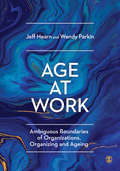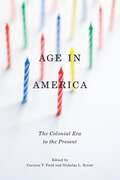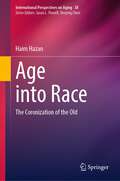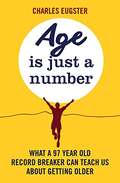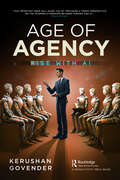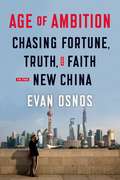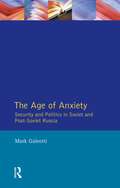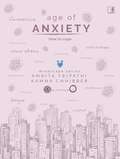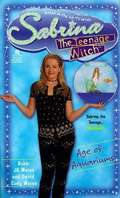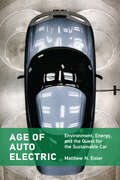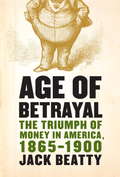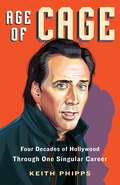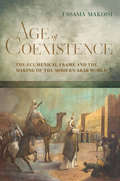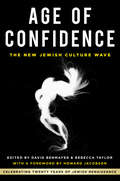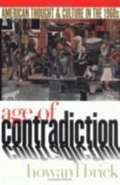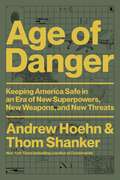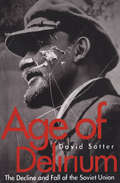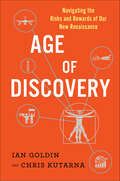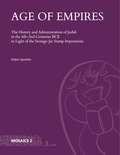- Table View
- List View
Age at Work: Ambiguous Boundaries of Organizations, Organizing and Ageing
by Jeff Hearn Wendy ParkinAge at Work explores the myriad ways in which ‘age’ is at ‘work’ across society, organizations and workplaces, with special focus on organizations, their boundaries, and marginalizing processes around age and ageism in and across these spaces. The book examines: how society operates in and through age, and how this informs the very existence of organizations; age-organization regimes, age-organization boundaries, and the relationship between organizations and death, and post-death the importance of memory, forgetting and rememorizing in re-thinking the authors’ and others’ earlier work tensions between seeing age in terms of later life and seeing age as pervasive social relations. Enriched with insights from the authors’ lived experiences, Age at Work is a major and timely intervention in studies of age, work, care and organizations. Ideal for students of Sociology, Organizations and Management, Social Policy, Gerontology, Health and Social Care, and Social Work.
Age at Work: Ambiguous Boundaries of Organizations, Organizing and Ageing
by Jeff Hearn Wendy ParkinAge at Work explores the myriad ways in which ‘age’ is at ‘work’ across society, organizations and workplaces, with special focus on organizations, their boundaries, and marginalizing processes around age and ageism in and across these spaces. The book examines: how society operates in and through age, and how this informs the very existence of organizations; age-organization regimes, age-organization boundaries, and the relationship between organizations and death, and post-death the importance of memory, forgetting and rememorizing in re-thinking the authors’ and others’ earlier work tensions between seeing age in terms of later life and seeing age as pervasive social relations. Enriched with insights from the authors’ lived experiences, Age at Work is a major and timely intervention in studies of age, work, care and organizations. Ideal for students of Sociology, Organizations and Management, Social Policy, Gerontology, Health and Social Care, and Social Work.
Age in America: The Colonial Era to the Present (Gender And American Culture Ser.)
by Nicholas L. Syrett Corinne T. FieldEighteen. Twenty-one. Sixty-five. In America today, we recognize these numbers as key transitions in our lives—precise moments when our rights and opportunities change—when we become eligible to cast a vote, buy a drink, or enroll in Medicare. This volume brings together scholars of childhood, adulthood, and old age to explore how and why particular ages have come to define the rights and obligations of American citizens. Since the founding of the nation, Americans have relied on chronological age to determine matters as diverse as who can marry, work, be enslaved, drive a car, or qualify for a pension. Contributors to this volume explore what meanings people in the past ascribed to specific ages and whether or not earlier Americans believed the same things about particular ages as we do. The means by which Americans imposed chronological boundaries upon the variable process of growing up and growing old offers a paradigmatic example of how people construct cultural meaning and social hierarchy from embodied experience. Further, chronological age always intersects with other socially constructed categories such as gender, race, and sexuality. Ranging from the seventeenth century to the present, taking up a variety of distinct subcultures—from frontier children and antebellum slaves to twentieth-century Latinas—Age in America makes a powerful case that age has always been a key index of citizenship.
Age into Race: The Coronization of the Old (International Perspectives on Aging #38)
by Haim HazanAge into Race is a socio-anthropological essay on the repercussions of the Covid-19 pandemic on the cultural status of the old. As the worldwide horrors of the Corona era have since been publicly repressed, the text is geared to revisit and relive the tenor of that time while considering its latent revolutionary aftermath. There was wide agreement that Covid-19 policies targeted older people as a risk group in need of protection, setting it apart from the rest of society. Yet, paradoxically, long-term facilities for older people effectively became Covid-19 death traps. What kind of abandonment propelled this apparent contradiction? This book provides an answer by looking at ageist practices regarding Covid-19 triaging, lockdowns and distancing that affected older people around the world, devising Covid-19 as an inevitable "problem of the elderly" and, by implication, instating and categorizing "the elderly" as a public problem to be bio-politically managed and wrought. The Covid-19 pandemic and its concomitant "state of emergency" triggered an accelerated transmutation of customary ageism into emergent racism, spelling a fatal switch to designating the old as bearers of "bare" life unworthy of human living, thus turning old age from a seemingly cultural category to a socially fabricated viral menace of nature. The book tracks down the process through which the "Coronization" of culture legitimized and impelled a further stigmatization of old age beyond mere ageism to sheer racism. Thus, this transmutation, while compromising their autonomy and subjectivity via imposed lockdowns, social isolation, excommunication and selective discrimination rendered the old a race apart. Subsequently, the moral panic invoked by the specter of the pandemic transformed the social perceptions of later life from a containable social problem to an unbridled public hazard that summoned total measures presented as bureaucratically regimented regulations that dehumanized its victims with impunity.
Age is Just a Number: What a 97 year old record breaker can teach us about growing older
by Charles EugsterRetired dental surgeon Charles Eugster rekindled a love of competitive rowing he'd neglected for most of his adult life at the age of 63. He took up bodybuilding at the age of 87. And at the age of 95 he started sprinting for the first time in his life, becoming World Champion at 200m indoor and 400m outdoor. He is a world record holder for his age group in a number of sports, and has 40 Gold Medals for World Masters Rowing. In this book, Charles shares his journey and his passionate belief that growing older needn't slow you down. And he shows his readers how taking on new challenges, learning new things, and improving your body as it ages is not only fun, but rewarding for the individual, and beneficial to society.
Age is Just a Number: What a 97 year old record breaker can teach us about growing older
by Charles EugsterRetired dental surgeon Charles Eugster rekindled a love of competitive rowing he'd neglected for most of his adult life at the age of 63. He took up bodybuilding at the age of 87. And at the age of 95 he started sprinting for the first time in his life, becoming World Champion at 200m indoor and 400m outdoor. He is a world record holder for his age group in a number of sports, and has 40 Gold Medals for World Masters Rowing. In this book, Charles shares his journey and his passionate belief that growing older needn't slow you down. And he shows his readers how taking on new challenges, learning new things, and improving your body as it ages is not only fun, but rewarding for the individual, and beneficial to society.
Age of Agency: Rise with AI
by Kerushan Govender"When the digital world started, many companies moved slowly and cautiously, not willing to replace their traditional operations. Now most companies have gone digital. We are now moving beyond digital into an AI world. Don't ignore it. This important book will guide you by providing a fresh perspective on the interrelationships between humans and AI." – Philip Kotler Do you feel overwhelmed by the AI wave? Worried that it could cost you your job, harm your business, or even take over? AI has pervaded our lives and is aggressively disrupting business. No person today can afford to ignore AI. Age of Agency is your companion, helping you leverage AI's capabilities to power your productivity and success. By understanding AI, you will learn to use it as a tool for personal career growth and business success. Former Microsoft executive Kerushan Govender demystifies AI, emphasising the importance of human agency. Reconnect with the needs of humanity and learn the importance of care as a differentiator in an AI world. Avoid the potential pitfalls of excessive reliance on the technology. Age of Agency is a blueprint for ensuring human agency outpaces computer agency. It boldly pits the limits of machine learning against the infinity of human ability. With this survival guide, you’ll uncover ways to connect with humanity on a deeper level, going beyond anything AI can do. Ready to become AI-savvy, with your humanity as your differentiator? Dive into the future with the confidence to ride the wave of today’s AI revolution.
Age of Ambition: Chasing Fortune, Truth, and Faith in the New China
by Evan OsnosWinner of the 2014 National Book Award in nonfiction. An Economist Best Book of 2014. A vibrant, colorful, and revelatory inner history of China during a moment of profound transformation From abroad, we often see China as a caricature: a nation of pragmatic plutocrats and ruthlessly dedicated students destined to rule the global economy-or an addled Goliath, riddled with corruption and on the edge of stagnation. What we don't see is how both powerful and ordinary people are remaking their lives as their country dramatically changes  As the Beijing correspondent for The New Yorker, Evan Osnos was on the ground in China for years, witness to profound political, economic, and cultural upheaval. In Age of Ambition, he describes the greatest collision taking place in that country: the clash between the rise of the individual and the Communist Party's struggle to retain control. He asks probing questions: Why does a government with more success lifting people from poverty than any civilization in history choose to put strict restraints on freedom of expression? Why do millions of young Chinese professionals-fluent in English and devoted to Western pop culture-consider themselves "angry youth," dedicated to resisting the West's influence? How are Chinese from all strata finding meaning after two decades of the relentless pursuit of wealth? Writing with great narrative verve and a keen sense of irony, Osnos follows the moving stories of everyday people and reveals life in the new China to be a battleground between aspiration and authoritarianism, in which only one can prevail.
Age of Anger: A History of the Present
by Pankaj MishraOne of our most important public intellectuals reveals the hidden history of our current global crisisHow can we explain the origins of the great wave of paranoid hatreds that seem inescapable in our close-knit world—from American shooters and ISIS to Donald Trump, from a rise in vengeful nationalism across the world to racism and misogyny on social media? In Age of Anger, Pankaj Mishra answers our bewilderment by casting his gaze back to the eighteenth century before leading us to the present.He shows that as the world became modern, those who were unable to enjoy its promises—of freedom, stability, and prosperity—were increasingly susceptible to demagogues. The many who came late to this new world—or were left, or pushed, behind—reacted in horrifyingly similar ways: with intense hatred of invented enemies, attempts to re-create an imaginary golden age, and self-empowerment through spectacular violence. It was from among the ranks of the disaffected that the militants of the nineteenth century arose—angry young men who became cultural nationalists in Germany, messianic revolutionaries in Russia, bellicose chauvinists in Italy, and anarchist terrorists internationally.Today, just as then, the wide embrace of mass politics and technology and the pursuit of wealth and individualism have cast many more billions adrift in a demoralized world, uprooted from tradition but still far from modernity—with the same terrible results.Making startling connections and comparisons, Age of Anger is a book of immense urgency and profound argument. It is a history of our present predicament unlike any other.
Age of Anxiety, The: Security and Politics in Soviet and Post-Soviet Russia
by Mark GaleottiThe geography of Russia -- vast, unwieldy, exposed -- and her tragic history of foreign invasion have created an overriding sense of military vulnerability amongst her leaders that, after the horrors of the Second World War, amounted almost to paranoia. This important study of the years since Brezhnev shows how this obsession with national security have been at the core of Russian thinking right through the reforms of the Gorbachev era and the eventual collapse of the USSR, and continues to dominate the turbulent politics of post-Soviet Russia today.
Age of Anxiety: How to Cope
by Amrita Tripathi Kamna Chhibber&‘What does it mean when someone says they have Anxiety?&’&‘I&’m stressed and nervous all the time, do I have Anxiety?&’&‘Will I ever get better?&’These are some of the questions we want to answer in this book. Is this the Age of Anxiety? Well, how could it not be – when so many millions of us feel that persistent combination of heart palpitations, impending doom, dread, even lack of control, as one of our contributors describes it. The question is, what can we do about it?Through this book we will learn how to distinguish between anxiety as 'an attack of the nerves' or something that will come and go, and Anxiety as a disorder, which will need treatment, including possibly therapy or medication. The conversations are even more pertinent given the global Covid-19 pandemic, prolonged periods of social isolation and an increased focus on mental health and wellness. We learn from coping with Anxiety Disorders, sharing their journey to healing, explaining exactly what would have helped them along the way, as they seek to bust common myths and misconceptions.
Age of Aquariums (Sabrina the Teenage Witch #20)
by Bobbi Weiss David WeissWhile cleaning up the school's new aquarium, Sabrina notices some rather unusual underwater inhabitants. Transforming herself into a tiny mermaid, she discovers the lost city of Atlantis...inside the fish tank! The great shrunken city is home to a mer-race so old it doesn't even remember its own origins. But the Atlanteans are sure that Sabrina is one of the legendary Conch Queens, come to take the city back to the Endless Waters. Sabrina wants to restore the city to its rightful place on the planet, but how can she do it without exposing her magic powers to Mr. Kraft and her mortal classmates? And what if someone doesn't want the lost city to be found?
Age of Auto Electric: Environment, Energy, and the Quest for the Sustainable Car (Transformations: Studies in the History of Science and Technology)
by Matthew N. EislerThe electric vehicle revival reflects negotiations between public policy, which promotes clean, fuel-efficient vehicles, and the auto industry, which promotes high-performance vehicles.Electric cars were once as numerous as internal combustion engine cars before all but vanishing from American roads around World War I. Now, we are in the midst of an electric vehicle revival, and the goal for a sustainable car seems to be within reach. In Age of Auto Electric, Matthew N. Eisler shows that the halting development of the electric car in the intervening decades was a consequence of tensions between environmental, energy, and economic policy imperatives that informed a protracted reappraisal of the automobile system. These factors drove the electric vehicle revival, argues Eisler, hastening automaking&’s transformation into a science-based industry in the process.Challenging the common assumption that the electric vehicle revival is due to the development of better batteries, Age of Auto Electric instead focuses on changing environmental and socioeconomic conditions, energy and environmental policies, systems of energy conversion and industrial production, and innovation practices that affected the prevalence and popularity of electric vehicles in recent decades. Eisler describes a world in transition from legacy to alternative energy-conversion systems and the promises, compromises, new problems, and unintended consequences that enterprise has entailed.
Age of Betrayal: The Triumph Of Money In America, 1865-1900
by Jack BeattyA senior editor at The Atlantic Monthly, Beatty tells how, having redeemed democracy during the Civil War, America betrayed it during the Gilded Age. That time, he says, saw the birth of the plutocracy and inequality that rules the country a century later. Annotation ©2007 Book News, Inc. , Portland, OR (booknews. com)
Age of Cage: Four Decades of Hollywood Through One Singular Career
by Keith Phipps“Age of Cage might be the closest we will get to understanding the singular beauty of each of Nic Cage’s always electric performances. You are holding the Rosetta Stone for Cage. Enjoy it.”—Paul Scheer, actor, writer and host of the How Did This Get Made? and Unspooled podcastsIcon. Celebrity. Artist. Madman. Genius. Nicolas Cage is many things, but love him, or laugh at him, there's no denying two things: you’ve seen one of his many films, and you certainly know his name. But who is he, really, and why has his career endured for over forty years, with more than a hundred films, and birthed a million memes?Age of Cage is a smart, beguiling book about the films of Nicolas Cage and the actor himself, as well as a sharp-eyed examination of the changes that have taken place in Hollywood over the course of his career. Critic and journalist Keith Phipps draws a portrait of the enigmatic icon by looking at—what else?—Cage’s expansive filmography.As Phipps delights in charting Cage’s films, Age of Cage also chronicles the transformation of film, as Cage’s journey takes him through the world of 1980s comedies (Valley Girl, Peggy Sue Got Married, Moonstruck), to the indie films and blockbuster juggernauts of the 1990s (Wild at Heart, Leaving Las Vegas, Face/Off, Con Air), through the wild and unpredictable video-on-demand world of today. Sweeping in scope and intimate in its profile of a fiercely passionate artist, Age of Cage is, like the man himself, surprising, insightful, funny, and one of a kind. So, snap out of it, and enjoy this appreciation of Nicolas Cage, national treasure.
Age of Coexistence: The Ecumenical Frame and the Making of the Modern Arab World
by Ussama MakdisiToday’s headlines paint the Middle East as a collection of war-torn countries and extremist groups consumed by sectarian rage. Ussama Makdisi’s Age of Coexistence reveals a hidden and hopeful story that counters this clichéd portrayal. It shows how a region rich with ethnic and religious diversity created a modern culture of coexistence amid Ottoman reformation, European colonialism, and the emergence of nationalism. Moving from the nineteenth century to the present, this groundbreaking book explores, without denial or equivocation, the politics of pluralism during the Ottoman Empire and in the post-Ottoman Arab world. Rather than judging the Arab world as a place of age-old sectarian animosities, Age of Coexistence describes the forging of a complex system of coexistence, what Makdisi calls the “ecumenical frame.” He argues that new forms of antisectarian politics, and some of the most important examples of Muslim-Christian political collaboration, crystallized to make and define the modern Arab world. Despite massive challenges and setbacks, and despite the persistence of colonialism and authoritarianism, this framework for coexistence has endured for nearly a century. It is a reminder that religious diversity does not automatically lead to sectarianism. Instead, as Makdisi demonstrates, people of different faiths, but not necessarily of different political outlooks, have consistently tried to build modern societies that transcend religious and sectarian differences.
Age of Confidence: Celebrating Twenty Years of Jewish Renaissance
by Howard Jacobson Rebecca Taylor David BenmayerTaking the terrorist attacks of 9/11 as their starting point, five new essays look at how Jewish culture has changed over the past two decades. Covering music (Vanessa Paloma Elbaz), art (Monica Bohm Duchen), literature (Bryan Cheyette), theatre (Judi Herman) and film (Nathan Abrams), the essays explore the role of confidence in the cultural output of minority communities, and ask whether the trends identified look set to continue over the coming years.Commissioned to mark the twentieth anniversary of Jewish Renaissance magazine, the book includes a foreword by Howard Jacobson and is interspersed with a selection of the best articles from the magazine’s archive, including pieces by the director Mike Leigh, author Linda Grant and sociologist Keith Kahn-Harris.
Age of Contradiction: American Thought and Culture in the 1960s
by Howard BrickIn Age of Contradiction, Howard Brick provides a rich context for understanding historical events, cultural tensions, political figures, artistic works, and trends of intellectual life. His lucid and comprehensive book combines the best methods of historical analysis and assessment with fascinating subject matter to create a three-dimensional portrait of a complicated time. In one of the only books on the 1960s to put ideas at the center of the period's history, Brick carefully explores the dilemmas, the promise, and the legacy of American thought in that time.
Age of Crowns: Pursuing Lives Marked by the Kingdom of God
by Kori de LeonYou were made for more than this life has to offer. That&’s why you never feel quite satisfied. Even when you feel happiest, discontent is always looming at the door. That&’s because God created you for something far greater than this life; He created you for Jesus Christ and His Kingdom.In Age of Crowns, Kori de Leon will awaken the dreamer in you as she invites you to explore glorious images of the Age to Come. Whether we realize it or not, God designed us for a:KING-to be loved and led by an excellent kingCROWN-to reflect dignity and worth as image-bearersKINGDOM-to have a purpose bigger than ourselves CASTLE-to find a secure sense of home This book is an inspiring examination of how the future hope of heaven changes your today. It will teach you how to faithfully await (and prepare for) the Age to Come, as well as how to live a more purposeful and fulfilling life with Christ here and now.
Age of Crowns: Pursuing Lives Marked by the Kingdom of God
by Kori de LeonYou were made for more than this life has to offer. That&’s why you never feel quite satisfied. Even when you feel happiest, discontent is always looming at the door. That&’s because God created you for something far greater than this life; He created you for Jesus Christ and His Kingdom.In Age of Crowns, Kori de Leon will awaken the dreamer in you as she invites you to explore glorious images of the Age to Come. Whether we realize it or not, God designed us for a:KING-to be loved and led by an excellent kingCROWN-to reflect dignity and worth as image-bearersKINGDOM-to have a purpose bigger than ourselves CASTLE-to find a secure sense of home This book is an inspiring examination of how the future hope of heaven changes your today. It will teach you how to faithfully await (and prepare for) the Age to Come, as well as how to live a more purposeful and fulfilling life with Christ here and now.
Age of Danger: Keeping America Safe in an Era of New Superpowers, New Weapons, and New Threats
by Andrew Hoehn Thom ShankerAn urgent look at how America's national security machine went astray and how it fails to keep us safe—and what we can do to fix it. Again and again, American taxpayers are asked to open their wallets and pay for a national security machine that costs $1 trillion operate. Yet time and time again, the US government gets it wrong on critical issues. So what can be done? Enter bestselling author Thom Shanker and defense expert Andrew Hoehn. With decades of national security expertise between them and access to virtually every expert, they look at what&’s going wrong in national security and how to make it go right. Age of Danger looks at the major challenges facing America—from superpowers like Russia and China to emerging threats like pandemics, cybersecurity, climate change, and drones—and reimagines the national security apparatus into something that can truly keep Americans safe. Weaving together expert analysis with exclusive interviews from a new generation of national security leaders, Shanker and Hoehn argue that the United States must create an industrial-grade, life-saving machine out of a system that, for too long, was focused only on deterring adversaries and carrying out global military operations. It is a timely and crucial call to action—a call that if heeded, could save Americans lives, money, and our very future on the global stage.
Age of Delirium: The Decline and Fall of the Soviet Union
by David SatterThe first state in history to be based explicitly on atheism, the Soviet Union endowed itself with the attributes of God. In this book, David Satter shows through individual stories what it meant to construct an entire state on the basis of a false idea, how people were forced to act out this fictitious reality, and the tragic human cost of the Soviet attempt to remake reality by force.“I had almost given up hope that any American could depict the true face of Russia and Soviet rule. In David Satter’s Age of Delirium, the world has received a chronicle of the calvary of the Russian people under communism that will last for generations.†?—Vladimir Voinovich, author of The Life and Extraordinary Adventures of Private Ivan Chonkin“Spellbinding. . . . Gives one a visceral feel for what it was like to be trapped by the communist system.†?—Jack Matlock, Washington Post“Satter deserves our gratitude. . . . He is an astute observer of people, with an eye for essential detail and for human behavior in a universe wholly different from his own experience in America.†?—Walter Laqueur, Wall Street Journal “Every page of this splendid and eloquent and impassioned book reflects an extraordinarily acute understanding of the Soviet system.†?—Jacob Heilbrunn, Washington Times
Age of Discovery: Navigating the Risks and Rewards of Our New Renaissance
by Ian Goldin Chris KutarnaThe present is a contest between the bright and dark sides of discovery. To avoid being torn apart by its stresses, we need to recognize the fact—and gain courage and wisdom from the past. Age of Discovery shows how.Now is the best moment in history to be alive, but we have never felt more anxious or divided. Human health, aggregate wealth and education are flourishing. Scientific discovery is racing forward. But the same global flows of trade, capital, people and ideas that make gains possible for some people deliver big losses to others—and make us all more vulnerable to one another. Business and science are working giant revolutions upon our societies, but our politics and institutions evolve at a much slower pace. That’s why, in a moment when everyone ought to be celebrating giant global gains, many of us are righteously angry at being left out and stressed about where we’re headed.To make sense of present shocks, we need to step back and recognize: we’ve been here before. The first Renaissance, the time of Columbus, Copernicus, Gutenberg and others, likewise redrew all maps of the world, democratized communication and sparked a flourishing of creative achievement. But their world also grappled with the same dark side of rapid change: social division, political extremism, insecurity, pandemics and other unintended consequences of discovery.Now is the second Renaissance. We can still flourish—if we learn from the first.
Age of Empires: The History and Administration of Judah in the 8th–2nd Centuries BCE in Light of the Storage-Jar Stamp Impressions (Mosaics: Studies on Ancient Israel #2)
by Oded LipschitsStorage jars of many shapes and sizes were in widespread use in the ancient world, transporting and storing agricultural products such as wine and oil, crucial to agriculture, economy, trade and subsistence. From the late 8th to the 2nd century BCE, the oval storage jars typical of Judah were often stamped or otherwise marked: in the late 8th and early 7th century BCE with lmlk stamp impressions, later in the 7th century with concentric circle incisions or rosette stamp impressions, in the 6th century, after the fall of Jerusalem, with lion stamp impressions, and in the Persian, Ptolemaic and Seleucid periods (late 6th–late 2nd centuries BCE) with yhwd stamp impressions. At the same time, several ad hoc systems of stamp impressions appeared: "private" stamp impressions were used on the eve of Sennacherib’s campaign, mwṣh stamp impressions after the destruction of Jerusalem, and yršlm impressions after the establishment of the Hasmonean state. While administrative systems that stamped storage jars are known elsewhere in the ancient Near East, the phenomenon in Judah is unparalleled in its scale, variety and continuity, spanning a period of some 600 years without interruption.This is the first attempt to consider the phenomenon as a whole and to develop a unified theory that would explain the function of these stamp impressions and shed new light on the history of Judah during six centuries of subjugation to the empires that ruled the region—as a vassal kingdom in the age of the Assyrian, Egyptian, and Babylonian empires and as a province under successive Babylonian, Persian, Ptolemaic, and Seleucid rule.
Age of Entanglement
by Kris Manjapra"Age of Entanglement "explores patterns of connection linking German and Indian intellectuals from the nineteenth century to the years after the Second World War. Kris Manjapra traces the intersecting ideas and careers of a diverse collection of individuals from South Asia and Central Europe who shared ideas, formed networks, and studied one another's worlds. Moving beyond well-rehearsed critiques of colonialism towards a new critical approach, this study recasts modern intellectual history in terms of the knotted intellectual itineraries of seeming strangers. Collaborations in the sciences, arts, and humanities produced extraordinary meetings of German and Indian minds. Meghnad Saha met Albert Einstein, Stella Kramrisch brought the Bauhaus to Calcutta, and Girindrasekhar Bose began a correspondence with Sigmund Freud. Rabindranath Tagore traveled to Germany to recruit scholars for a new Indian university, and the actor Himanshu Rai hired director Franz Osten to help establish movie studios in Bombay. These interactions, Manjapra argues, evinced shared responses to the cultural and political hegemony of the British empire. Germans and Indians hoped to find in one another the tools needed to disrupt an Anglocentric world order. As Manjapra demonstrates, transnational intellectual encounters are not inherently progressive. From Orientalism and Aryanism to socialism and scientism, German-Indian entanglements were neither necessarily liberal nor conventionally cosmopolitan, often characterized as much by manipulation as by cooperation. "Age of Entanglement "underscores the connections between German and Indian intellectual history, revealing the characteristics of a global age when the distance separating Europe and Asia seemed, temporarily, to disappear.
